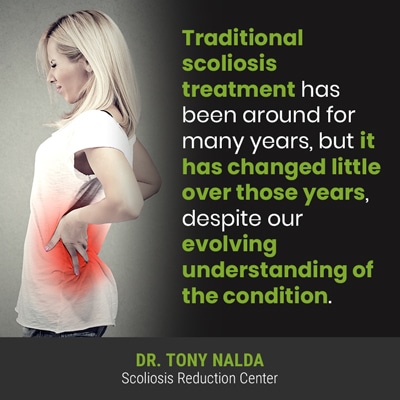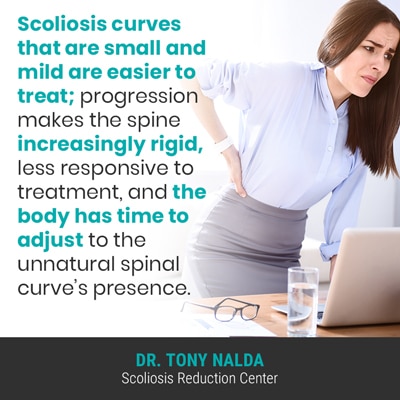As a progressive spinal condition, mild scoliosis isn’t necessarily going to stay mild; only proactive treatment can counteract the condition’s progressive nature. If left untreated, or not treated proactively, mild scoliosis is virtually guaranteed to get worse.
When we’re talking about mild scoliosis, we’re referencing the first stop on the condition’s progressive line: mild to moderate and severe to very severe. How a diagnosis of mild scoliosis is responded to is key to whether it will remain mild or progress.
There are two main scoliosis treatment approaches for patients to choose between, and each leads to a different potential outcome, based on how it responds to a diagnosis of mild scoliosis.
What is Scoliosis?
Scoliosis is a progressive structural spinal condition that involves the development of an unnatural sideways spinal curvature that also rotates, meaning the spine bends unnaturally to the side and also twists from front to back, back to front.
The rotational component makes scoliosis a 3-dimensional condition, and a measurement known as Cobb angle classifies conditions in terms of severity:
- Mild scoliosis: Cobb angle measurement of between 10 and 25 degrees
- Moderate scoliosis: Cobb angle measurement of between 25 and 40 degrees
- Severe scoliosis: Cobb angle measurement of 40+ degrees
- Very-severe scoliosis: Cobb angle measurement of 80+ degrees
So because scoliosis is progressive, even if it’s diagnosed as mild doesn’t mean that’s where it will stay, because its nature is to get worse over time, so how a diagnosis of mild scoliosis is responded to, in terms of treatment, will determine whether or not the condition’s progressive nature is counteracted.
Now, although there are different types of scoliosis, with different etiologies, the most prevalent is adolescent idiopathic scoliosis (AIS), diagnosed between the ages of 10 and 18, and the idiopathic designation means not clearly associated with a single-known causative source.
While we don’t fully understand why AIS initially develops, we do know how to treat it, and we do understand what causes it to progress: growth and development.
Idiopathic scoliosis accounts for 80 percent of known diagnosed cases, so we’ll focus on AIS throughout the article, and the remaining 20 percent are associated with known causes.
Now that we’ve defined the condition and some of its key characteristics, let’s move on to exploring the two main scoliosis treatment approaches: traditional and conservative.
Traditional Scoliosis Treatment of Mild Scoliosis: Watching and Waiting

Traditional scoliosis treatment has been around for many years, but it has changed little over those years, despite our evolving understanding of the condition.
Traditional treatment commonly responds to a diagnosis of mild scoliosis with the recommendation that as the condition is mild, it should be monitored for signs of progression, but it doesn’t start treatment quite simply because it doesn’t have a strategy for treating scoliosis while mild, only when it becomes severe enough for patients to become surgical candidates.
In the moderate-to-severe stage of progression, the only form of treatment applied is traditional bracing, which is associated with a number of shortfalls.
Traditional braces like the boston is limited in its efficacy for a number of reasons:
- Only treats the condition as 2-dimensional, ignoring its rotational component
- Works by squeezing the spine, known to weaken it
- Brace is mass produced and uncomfortable to wear = compliance issues
- Goal of the brace is to stop progression, not correction
- Design has changed little since its inception in the ‘70s.
So if a boston brace fails to stop a condition from progressing, which is common, the next level of progression is severe, and once scoliosis becomes severe, and shows signs of continued progression, patients are commonly funneled towards spinal fusion surgery.
The goal of spinal fusion is also to stop progression, and it does so by fusing the curve’s most-tilted vertebrae into one solid bone to eliminate movement (progression) in the area, and commonly, rods are attached to the spine with screws to hold the spine in place.
When successful, spinal fusion can stop progression, but it can come at a high cost: the spine’s natural strength and function.
A spine that has a section that’s fused, immoveable, and held in position by artificial means is one that’s more vulnerable to injury and is going to be less flexible, likely with a reduced range of motion.
Spinal rigidity also leads to sore and strained muscles surrounding the spine, and many patients report an increase in pain post-surgery.
The path of traditional treatment is a prime example of what can happen when a diagnosis of mild scoliosis isn’t treated proactively.
The reality is that most cases of scoliosis can be treated nonsurgically, and here at the Scoliosis Reduction Center®, a conservative chiropractic-centered treatment approach responds to a diagnosis of mild scoliosis with an active effort to reduce the curve while treatment success is the most likely.
Conservative Scoliosis Treatment of Mild Scoliosis: Proactive Response
Here at the Center, I want to start treatment as close to the time of diagnosis as possible, regardless of severity, and when it comes to mild scoliosis, this is where I can make the biggest impact.

Scoliosis curves that are small and mild are easier to treat; progression makes the spine increasingly rigid, less responsive to treatment, and the body has time to adjust to the unnatural spinal curve’s presence.
In addition, the longer a scoliosis is left to progress, the longer the body is exposed to the condition’s uneven forces, which commonly causes postural deviation and pain (more common in adults).
With postural deviation and an unnaturally-curved spine comes sore and strained muscles and related muscle imbalance; it’s not just the spine that’s in charge of maintaining its natural curves/alignment, but also its surrounding muscles.
Here at the Center, treatment involves integrating multiple condition-specific treatment disciplines so conditions can be impacted on every level.
Chiropractic Care
As a structural condition, scoliosis has to be primarily impacted on a structural level, and I work towards this through a series of chiropractic techniques and manual adjustments that can reposition the most-tilted vertebrae back into alignment with the rest of the spine.
By addressing areas of vertebral subluxation, as much as possible of the spine’s natural curvatures are restored, improving the spine’s biomechanics, function, and health.
Physical Therapy
As mentioned, the spine’s surrounding muscles play a role in spinal health, and through physical therapy and a variety of scoliosis-specific exercises (SSEs), I can help patients increase core strength so their spines are optimally supported/stabilized by its surrounding muscles
In addition, certain SSEs are known to activate specific areas of the brain for improved brain-body communication, postural remodeling, and a better body position.
Corrective Bracing
Corrective bracing, as the name suggests, has correction as its end goal, not solely stopping progression, and when combined with other forms of proactive treatment, corrective bracing can be particularly effective on growing spines.
Unlike traditional bracing, corrective braces, like the ScoliBrace address the condition’s true 3-dimensional nature, increasing potential treatment efficacy.
Other pros of corrective bracing include:
- Having correction as its end goal
- Pushing the spine into a corrective position, rather than squeezing it
- Customization to address specific body/condition types
- More comfortable to wear = better compliance rates
- Improves postural deviation
Rehabilitation
Although scoliosis is progressive and incurable, it is highly treatable, and one facet of treatment is rehabilitation.
There are never treatment guarantees, but with adolescent idiopathic scoliosis, the goal is to reduce and/or hold a scoliotic curve where it is, despite the constant trigger of growth.
A series of custom-prescribed exercises can help patients establish a home-rehabilitation program to further stabilize the spine for long-term sustainable treatment results.
Conclusion
So for those recently diagnosed with scoliosis, deciding on how to treat it is the most important decision moving forward as different treatment approaches produce different potential outcomes.
As traditional treatment responds to a diagnosis of mild scoliosis with watching and waiting, nothing is being done to stop the curvature from progressing, so to me, this is wasting valuable treatment time.
Remember, while there are never treatment guarantees, early detection and proactive treatment does increase chances of treatment success.
Conservative treatment has correction as its end goal and works towards preventing progression, escalating symptoms, and the need for more invasive treatment in the future, made possible through proactive treatment started, whenever possible, while the condition is still mild.
Treating scoliosis while mild means the curve is at its smallest, the spine is at its most flexible, making it more responsive to treatment, and the body hasn’t yet adjusted to the unnatural spinal curves presence.
So for those recently diagnosed, regardless of severity, the best time to start treatment is always now, and reaching out can be the first step on the path to successful treatment.




